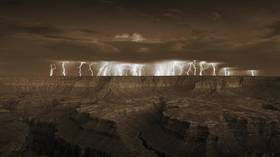Astronomers detect ferocious storms wheeling across surface of ‘failed star’ 6.5 light years away (VIDEO)

Scientists using cutting-edge techniques and instruments have detected vast storms sweeping across the face of a brown dwarf star 6.5 light-years from Earth, developing our long-range scanning capabilities in the hunt for life.
While 6.5 light-years might seem relatively close on the cosmic scale, the brown dwarf, or failed star, is still 379438.2 AUs away (an Astronomical Unit is the mean distance between the Earth and the Sun), and therefore extremely difficult to observe in any kind of detail.
This is the first time astronomers have detected such turbulence on such a distant object using a technique called polarimetry, or measuring objects based on the way the light they emit is twisted and distorted.
"Polarimetry is receiving renewed attention in astronomy," said astronomer Dimitri Mawet of Caltech and the Jet Propulsion Laboratory.
Also on rt.com Alien life could thrive on hydrogen worlds says new study, forcing rethink of how we hunt for ETThe technique is used to study objects as disparate as supermassive black holes, newborn stars and even objects as small as exoplanets or, as in this case, brown dwarfs.
"[It] is a very difficult art, but new techniques and data analysis methods make it more precise and sensitive than ever before."
These advances allowed postdoctoral scholar in astronomy Maxwell Millar-Blanchaer and his colleagues at Caltech to observe the binary brown dwarf system called Luhman 16AB located in the Vela constellation in unprecedented detail, showing stripes of cloud that encircle the entire planet, much like the vast storms that sweep across Jupiter.
"We think these storms can rain things like silicates or ammonia. It's pretty awful weather, actually," said astronomer Julien Girard of the Space Telescope Science Institute.
As the technique develops and is refined even further and put to use with increasingly-advanced instruments, it will be used to study the weather patterns and atmospheres of exoplanets to identify the conditions for life.
Like this story? Share it with a friend!














